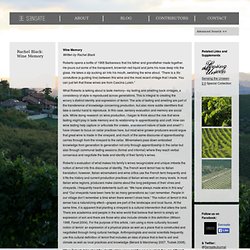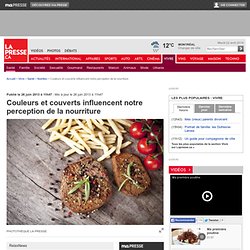

Ophone : envoyez des odeurs par SMS ou emails ! Whim. Matters of Taste. Growing up in the African country of Togo, Mansour Ourasanah knew what it was like to be hungry.

But he assumed that limited food was a universal misfortune, like a head cold or a broken heart. Eventually he discovered that plenty of food was available for people with money; it was just that his family was poor. Now 28 and an industrial designer in Chicago, Mr. Ourasanah has tried to startle others into new ways of thinking about food.
Last month he won a $35,000 Vilcek Prize for Creative Promise for Lepsis, his handsome prototype for a system that breeds grasshoppers to eat. Mr. Today, designers are playing with food in growing numbers. Photo Once you have reared your grasshoppers, for instance, Susana Soares, a designer and researcher in London, has a plan for what you can do with them. And when you’re ready to clean the mixing bowl ... don’t bother. Soon, other designers were taking up food as a medium. Sensate Journal Rachel Black: Wine Memory » Sensate Journal. Wine MemoryWritten by Rachel Black Roberto opens a bottle of 1968 Barbaresco that his father and grandfather made together.

He pours out some of the transparent, brownish-red liquid and jams his nose deep into the glass. Sensate Journal Guest Editors Emily Zeamer, Stefan Helmreich, & Heather Paxson: Sensing the Unseen 2.0 » Sensate Journal. Sensing the Unseen: An InfraductionBy Stefan Helmreich, Heather Paxson, and Emily Zeamer [Sensing the Unseen 2.0 Special Collection] How should scholars in the social sciences, humanities, and arts comprehend, apprehend, and represent the domain of the unseen?

The unheard? The untouched? The untasted? Speakers, discussants, conveners, and audience members talked through how to portray the-just-out-view, how to listen for presences at the edges of social perception, how to pry into processes difficult to communicate intersubjectively — such as pain or trauma — how to capture evanescent worlds of taste, how to measure or account for processes outside of everyday palpability or scale (e.g., radiation, climate change, global finance). This “Sensing the Unseen” collection on Sensate revisits and remixes those 2010-2011 conversations (the original organization, along with podcast documentation of the talks, can be found at the Sensing the Unseen website). Think Twice: How the Gut's "Second Brain" Influences Mood and Well-Being. As Olympians go for the gold in Vancouver, even the steeliest are likely to experience that familiar feeling of "butterflies" in the stomach.

Underlying this sensation is an often-overlooked network of neurons lining our guts that is so extensive some scientists have nicknamed it our "second brain". A deeper understanding of this mass of neural tissue, filled with important neurotransmitters, is revealing that it does much more than merely handle digestion or inflict the occasional nervous pang. The little brain in our innards, in connection with the big one in our skulls, partly determines our mental state and plays key roles in certain diseases throughout the body.
Although its influence is far-reaching, the second brain is not the seat of any conscious thoughts or decision-making. This multitude of neurons in the enteric nervous system enables us to "feel" the inner world of our gut and its contents. Neil Harbisson : J'écoute les couleurs. How Evolution Determines The Flavor Of Beer and Whiskey. Back in August of 2011, unconventional chef David Chang stood up in front of a gathering of chefs and other food people in Copenhagen to give a talk about food and microbiology. He opened his presentation by apologizing to the audience: “we know so little about [microbiology], that I'm going to be the one talking to you about it.” Chang went on to describe his experiments creating unique fermented flavors for high-end dishes. And Chang is not the only chef to have pushed the boundaries of microbial science in pursuit of gastronomy.
Rene Redzepi’s Nordic Food Lab creates their own fish sauce using local fish. Husband and wife team Alex Talbot and Aki Kamozawa tinker with a wide variety of bespoke vinegars. Couleurs et couverts influencent notre perception de la nourriture. «La façon dont nous percevons la nourriture est une expérience multisensorielle qui implique non seulement le goût et la texture des aliments, mais aussi l'arôme et la vue», résument les auteurs de l'étude, publiée dans la revue scientifique Flavour.

«Avant même que la nourriture soit dans notre bouche, notre cerveau a déjà formé un jugement sur elle, ce qui affecte l'ensemble de notre expérience alimentaire», affirment les chercheurs de l'Université britannique d'Oxford. La couleur rouge serait particulièrement dissuasive. «Le rouge pourrait être utilisé pour présenter de la nourriture aux gens qui doivent rationner leur alimentation, mais certainement pas pour ceux dont le poids est trop faible», affirme l'étude. Les chercheurs ont procédé à une batterie de tests à l'aide de couverts de différentes couleurs, formes, matières et poids, pour évaluer leur impact gustatif sur des dizaines de volontaires.
Wine-tasting: it's junk science. Every year Robert Hodgson selects the finest wines from his small California winery and puts them into competitions around the state.
